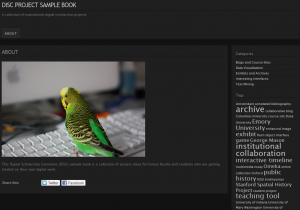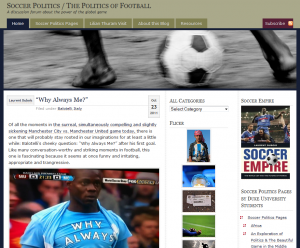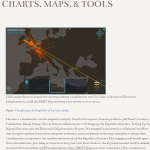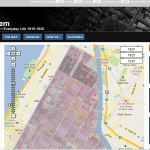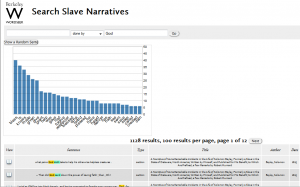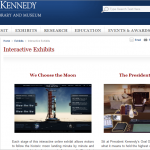Last Monday, I attended one of the Workshops on Digital Scholarship being offered through the Emory Digital Scholarship Commons this semester. This series offers workshops on a variety of topics ranging from “Creating an Online Presence I: Take Control of Your Online Personality” to “Hack Your Theme: Customize WordPress Themes with CSS and HTML” – all of them speak to topics relevant to Brittain Fellows and they are held at Emory Library on Mondays from 12-1pm and are repeated on Thursdays from 6-7pm.
The workshop I attended was a “Digital Humanities Show and Tell” and it was run by the resident CLIR Post-Doctoral fellow, Dr. Brian Croxall. The session was designed to highlight some of the most innovative digital projects and discuss the role of digital scholarship in general.
Brian started out by talking more generally about what a digital project is. Brian defines a digital project as one that incorporates digital technology to do something that couldn’t be done in the same way with print materials. The digital, he stressed, is not the end point. Rather we can use digital tools to generate data which we can then analyze, interpret, and visualize in a way that makes an argument or supports a hypothesis.
In the spirit of “Show and Tell,” Brian went on to showcase several examples of digital projects that use different tools and platforms to achieve different end results. These sample projects are housed on the Emory DiSC’s Project Sample Book.
The website divides the projects into categories, and Brian walked us through a few examples from each:
Blogs and Course Sites:
These are often collaborative, co-authored blogs, or blogs designed and run by professors to serve as class blogs. Many are housed on blogging platforms like WordPress that make building blogs relatively easy and offer a lot of design choices and useful add-ons.
One example that Brian highlighted to showcase the collaborative and multimedia possibilities of the blog as platform for student writing is the Duke University course website “Soccer Politics/The Politics of Football”.
So why, Brian asked, is this good digital scholarship? One of the main reasons is the public platform that blogs provide – for scholars and students alike, writing posted on blogs is visible to an audience that can respond to the post and possibly share it with an even larger audience. As a pedagogical tool, Brian noted, blogs allow student writing to reach an audience of scholars who can engage in conversations with the students about the subjects they are exploring. (This has happened in Brian’s own class, Introduction to the Digital Humanities, in which students have had the scholars whose work they are reflecting upon in blog posts respond to their posts in the comments).
Data Visualizations:
The next category of Digital Scholarship that Brian showcased was Data Visualizations. These projects use digital tools to visualize data sets that then allow scholars to recognize patterns and develop arguments about the texts or artifacts they are analyzing. Not only does this allow for innovative and rigorous scholarship but it also makes our work more publicly accessible – to quote Brian, “Maps are easier to read than dissertations!”
The DiSC sample book highlights several of these projects, but one of the most impressive is the “Mapping the Republic of Letters” project coming out of Stanford University. Another exciting project is “Digital Harlem”which, as the DISC website describes, “presents information, drawn from legal records, newspapers and other archival and published sources, about everyday life in New York City’s Harlem neighborhood in the years 1915-1930.”
Exhibits and Archives:
Brian then turned to the next category, Exhibits and Archives. These are websites that bring together large collections of digital materials and display them in a virtual forum, often building on platforms like Omeka. Many of them allow for searching by various tags and keywords, allowing scholars to access large amounts of data and search them in a manageable fashion.
One highlighted project, the Walt Whitman Archive consolidates all the different editions and makes them searchable, allows scholars to see actual page images of the texts, and offers downloadable teaching materials. Another site, http://gulaghistory.org/ serves as both an exhibit and an archive, allowing for virtual tours and searchable databases of texts and archives.
Text Mining:
Many of the exhibits and archives are searchable using Text Mining techniques. Text mining projects allow users to run different types of searches on large amounts of data and modify those searches in different ways. Brian discussed the site Wordseer as an example (although it is not yet included on the DiSC project sample book).
Wordseer, a project that comes out of Berkeley, contains an archive of slave narratives in a searchable database. It allows the user to search by keyword and then modify by words connected to that word. The results can be visualized with graphs, bar charts, and “heat maps.”
Other projects featured on DiSC’s project sample book include, the Vincent Van Gogh letters, the Mark Twain Project, the Digital Scriptorium, and the Emory Women Writers Resource Project.
Interesting Interfaces:
The final set of digital projects that Brian showcased use “Interesting interfaces” to display artifacts or information. Using the John F. Kennedy Presidential Library and Museum’s “President’s Desk” exhibit as an example, Brian emphasized that visual design and interactivity can go a long way toward making humanities projects accessible and appealing. Or, as Brian put it, “just because we’re scholars doesn’t mean [our work] can’t be interesting and pretty.”
All in all, it was a great “food for thought” session – although I had heard of some of these projects, it was really helpful to see someone play around with them and run sample searches to demonstrate the different functions of the sites. It’s also a terrific resource to have a central location where great examples of digital scholarship are showcased – I’ll definitely be returning to the DiSC Project Sample Books frequently to get ideas for my own digital projects.

